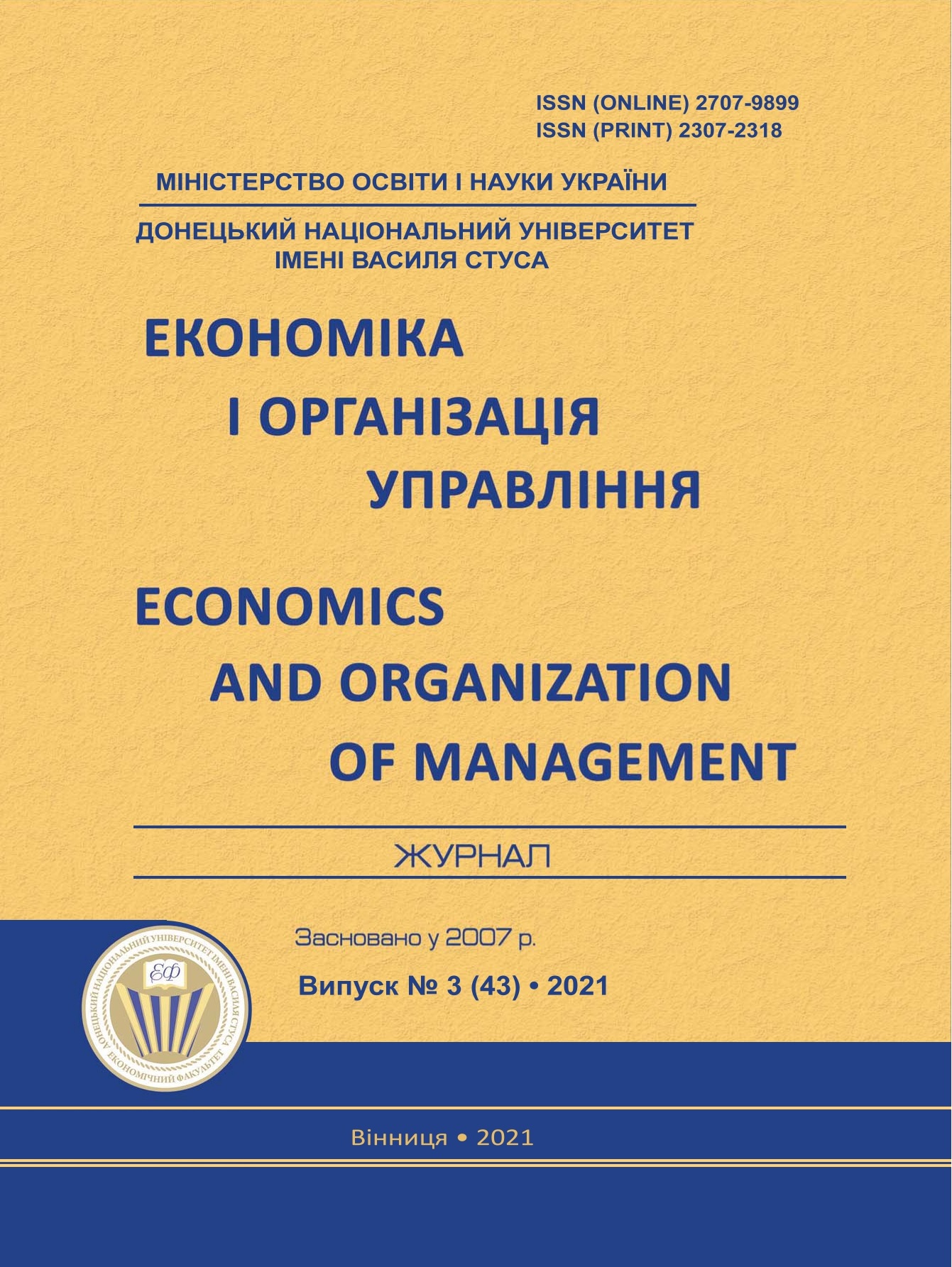Assessment of compliance costs in the banking market
DOI:
https://doi.org/10.31558/2307-2318.2021.3.2Keywords:
banking market; deadweight loss; intervention costs; market regulation; compliance costsAbstract
In the field of the economics’ regulation researchers so far have built the conceptual framework showing how the deadweight loss of market failures decrease and costs of the government intervention increase with the increased level of the government intervention. To quantify relationships between the level of intervention, intervention costs and the deadweight loss with econometric models it is important to understand how to quantify the market participants’ compliance costs as a part of intervention costs. The objective of the research presented in this paper is to find the appropriate methodology for the quantification of the market participants’ compliance costs in the banking market.
Research presents bank compliance cost assessment methodology, showing that main components there are operational costs and appropriate parameter representing fraction of operational costs. Methodology’s validation shows that in general it works as expected, i.e., higher government intervention levels lead to higher bank compliance costs, at the same time this general rule has some adjustments: when the intervention becomes more intense the cost rise increases.
Research results will be used to assess all government intervention costs (other positions include regulation costs and other indirect costs) and finalize the quantification of the framework. Quantified framework could be used for more precise policy making regarding the regulation of the banking market.
References
Ajefu, J. B., & Barde, F. (2015). Market efficiency and government intervention revisited: What Do recent Evidence Tell Us? Journal of International Business and Economics, 3(1), 20– 23. https://doi.org/10.15640/jibe.v3n1a3
Allen, F., & Carletti, E. (2013). Systemic risk from real estate and macro-prudential regulation. International Journal of Banking, Accounting and Finance, 5(1/2), 28–48. https://doi.org/10.1504/IJBAAF.2013.058091
Arrow, K. J. (1970). The organization of economic activity: Issues pertinent to the choice of market versus nonmarket allocation. Public expenditure and policy analysis. Chicago: Rand MacNally College Publishing Company, 67–81.
Arrow, K. J. (1985). The potentials and limits of the market in resource allocation. In G. R. Feiwel (Ed.), Issues in Contemporary Microeconomics and Welfare (pp. 107–124). Palgrave Macmillan, London. https://doi.org/10.1007/978-1-349-06876-0_2
Bator, F. M. (1958). The anatomy of market failure. The Quarterly Journal of Economics, 72(3), 351–379. https://doi.org/10.2307/1882231
Besanko, D., & Braeutigam, R. (2011). Microeconomics (4th ed., parts 1, pp. 4–7). United States: John Wiley & Sons, Inc.
Besley, T. (2010). How do market failures justify interventions in rural credit markets? The World Bank Research Observer, 9(1), 27–47. https://doi.org/10.1093/wbro/9.1.27
Bjornstad, D. J., & Brown, M. A. (2004). A market failures framework for defining the government’s role in energy efficiency. Joint Institute for Energy and Environment, JIEE 2004-02.
Bloomberg Finance L.P. (n.d.). Financial statements of Swedbank AB, Siauliu Bankas AB, SEB AB, Rietumu Banka AS, Luminor Bank AS, LHV Pank AS. Retrieved from Bloomberg database.
EBA (2020). Explanatory note to the EBA study of institutions’ reporting costs under Article 430(8) CRR. European Banking Authority, 22 July 2020. Retrieved from https://www.eba.europa.eu/regulation-and-policy/supervisory-reporting/cost-compliancesupervisory-reporting
European Commission (n.d.). EU banking and financial services law. Retrieved from https://ec.europa.eu/info/law/law-topic/eu-banking-and-financial-services-law_en
Eurostat (n.d.). Harmonised Index of Consumer Prices. Retrieved from https://ec.europa.eu/eurostat/data/database
Finantsinspektsioon (n.d.). The Estonian Financial Services Market as at 31 December 2020. Retrieved from https://www.fi.ee/en/publications/estonian-financial-services-market31122020#h2-1
FKTK (n.d.). Reports of the credit institutions. Retrieved from https://www.fktk.lv/statistika/kreditiestades/publiskie-ceturksna-parskati-banku-dalijuma/
Freimanis K., Šenfelde M. (2020). Approach of Scaling the Level of Government Intervention in the Financial Market. 11th International Scientific Conference, electronic proceedings of VGTU, 2020, Vilnius, Lithuania. https://doi.org/10.3846/bm.2020.591
Hertog, J. (2010). Review of economic theories of regulation (Discussion Paper Series 10–18). Tjalling C. Koopmans Research Institute.
ICF (2019). Study on the costs of compliance for the financial sector. European Commission, ISBN 978-92-79-81800-4, doi:10.2874/068657
Grochulski, B., & Morrison, W. (2014). Understanding market failure in the 2007–08 Crisis. Economic Brief of Federal Reserve Bank of Richmond, EB14–12.
Jehle, G. A., & Reny, P. J. (2011). Advanced microeconomic theory (3rd ed., chapters 4, 8). United Kingdom: Pearson Education Limited.
Lietuvos bankas (2020). Bank Activity Review. Retrieved from https://www.lb.lt/en/reviewsand-publications/category.39/series.171?category=&series=&ff=1
Mankiw, N. G. (2009). Principles of microeconomics (5th ed., parts 2–5). United States: SouthWestern Cengage Learning.
NSW. (2017). Market failure guide. A guide to categorising market failures for government policy development and evaluation. State of New South Wales through Department of Industry. OECD (2014).
OECD (Organisation for Economic Co-operation and Development) Regulatory Compliance Cost Assessment Guidance. OECD Publishing. http://dx.doi.org/10.1787/9789264209657-en
Renda, A. et al. (2013). Assessing the costs and benefits of regulation. Study for the European Commission, Secretariat General. Retrieved from https://ec.europa.eu/smartregulation/impact/commission_guidelines/docs/131210_cba_study_sg_final.pdf
Rosengard, J. K., & Stiglitz, J. E. (2015). Economics of the public sector (4th ed., chapter 4). New York: W. W. Norton & Company, Inc.
Rubinfeld, D. L., & Pindyck, R. S. (2013). Microeconomics (8th ed., parts 1, 4). United States: Pearson Education, Inc.
Shubik, M. (1970). On different methods for allocating resources. KYKLOS, 23(2) 332–337. https://doi.org/10.1111/j.1467-6435.1970.tb02562.x
Simkovic, M., & Zhang, M.B. (2019). Measuring Regulation. Summer Institute 2019 Law and Economics, conference proceedings, 2019, Boston, USA. Retrieved from http://conference.nber.org/conf_papers/f125600.pdf
Stiglitz, J. E. (2000). Economics of the public sector (3rd ed., chapter 4). New York: W. W. Norton & Company, Inc.
World Bank. (2001, 2003, 2007, 2011, 2019, 2021). Bank regulation and supervision survey. The World Bank. https://www.worldbank.org/en/research/brief/BRSS

